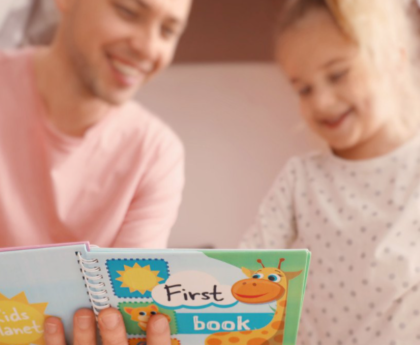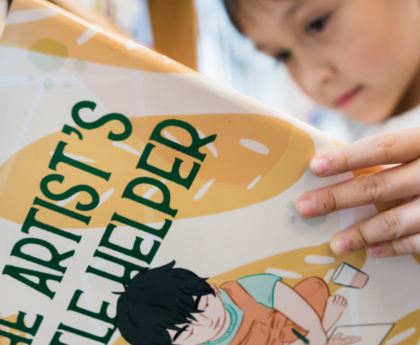A child’s reading development happens at multiple levels: individual, familial, social, emotional, cognitive, and environmental, to name a few. All these aspects of reading can (and should!) involve positive experiences. When facilitated well, literacy education helps your child grow into a strong, curious reader who loves to learn. One way to initiate this early development is with interactive reading activities.
Learn how you can use interactive reading as a way to engage your child in books and stories. In this article, we share some tips and interactive reading ideas to try with your child.
What is Interactive Reading?
Interactive reading—also known as an interactive read-aloud—is when a teacher or parent actively involves students in the story they read. Children not only listen to the story being read but also pause to reflect, ask questions, point out their observations, and participate in the storytelling process.
This can be done with children of all ages, from babies to teens. The interactions vary depending on the age of the group, the goals for interactive reading, and the content being read.
For pre-readers, the interactive read-aloud method is important to their literacy development because:
- It reinforces reading comprehension skills through active listening
- Students practice making predictions about the story
- It gives students the chance to retell events and summarize what they’ve heard, which strengthens their awareness of story structure
- Kids get to explore books through different modalities, such as hands-on activities, speaking, listening, and critical thinking
- It introduces early readers to new vocabulary words and concepts
- It engages students with stories in an enjoyable way
An interactive reading practice invites children to become active participants in literacy experiences. Using physical objects, props, games, or role-playing also adds an element of play to the reading experience, building the child’s knowledge and interest in literacy.
Fun Interactive Reading Activities
Whether you’re reading with your child or a group of young students, interactive reading is fun and effective. Consistent, interactive reading encourages better comprehension, strong vocabulary development, and a cherished bonding experience. Here are some activities to try.
Use Expressive Voices
Be extra expressive when reading to young kids. Vary your pace, pitch, and volume to hold their interest. Using different character voices is also a fun way to engage listeners in the story and help them understand different personalities and contexts. Playing with voices can also model fluent reading which showcases how reading can sound like speaking.
Act Out the Story
If your child wants to be part of the characters’ voices or enjoys acting things out, encourage them to play their favorite scenes from the book. You can act out the story together as if you’re the characters. The hands-on approach reinforces their comprehension of the story and strengthens their vocabulary as they try to make the storyline “real.”
Guess What Happens Next
During an interactive read-aloud, pause after one of the important parts of the story and ask your child if they can guess what happens next. This gives them a chance to make predictions, keeping them engaged as the story unfolds.
Tell the Story Your Way
After reading a new book aloud, have your child retell the story in their own words. This practice reinforces their sequencing abilities, improves comprehension, and lets them practice narrative skills. If needed, you can prompt them with specific questions like, “What did the snail say to the cat?”
Build a Storyboard
Use a felt board and some velcro character cutouts to recreate the story visually with your kids. As you read the book aloud, ask your child to move the characters around and select new objects to add to the board to reflect what’s going on in the story.
Interactive Read-Alouds: Tips for Parents
Whether or not you have a specific activity in mind, you and your child can practice interactive reading at any time with any children’s book. Keep the following best practices in mind the next time you want to make storytime more playful!
- Be enthusiastic. Emphasize your interest and enjoyment of the book so your child can follow along.
- Involve your child. Encourage your child to repeat words and phrases, make silly sounds, or fill in the words they think might come next.
- Choose age-appropriate books. Choose books your child is interested in. Read their favorites repeatedly and let them take over the parts of the story they know best.
- Ask open-ended questions. Go beyond simple recall by asking questions starting with “what,” “why,” and “how” to promote creative discussion.
- Praise and encourage your child’s participation. Acknowledge your child’s activity and interest during the read-aloud. Offer smiles, responses, and words of praise when they remain interactive.
- Be patient and have fun! Reading aloud should be an enjoyable bonding experience, not a chore. If your child loses interest, take a break and come back to it later.
By making interactive reading an engaging, low-stress routine, you nurture your child’s literacy development while strengthening your parent-child connection. The key is keeping it lighthearted and positive—consistent, engaged reading practice is one of the most important parts of your child’s literacy journey!
Find Interactive Reading Activities at Reading.com
Turn storytime into a playful experience that supports literacy development and fosters your child’s interest in books. By practicing some of these activities and staying present with your child during read-alouds, you fuel your student’s journey toward lifelong learning.
To discover more interactive reading activities, download the Reading.com app. We combine evidence-based literacy instruction with playful reading lessons for kids and their parents. Get started with a free trial today.





